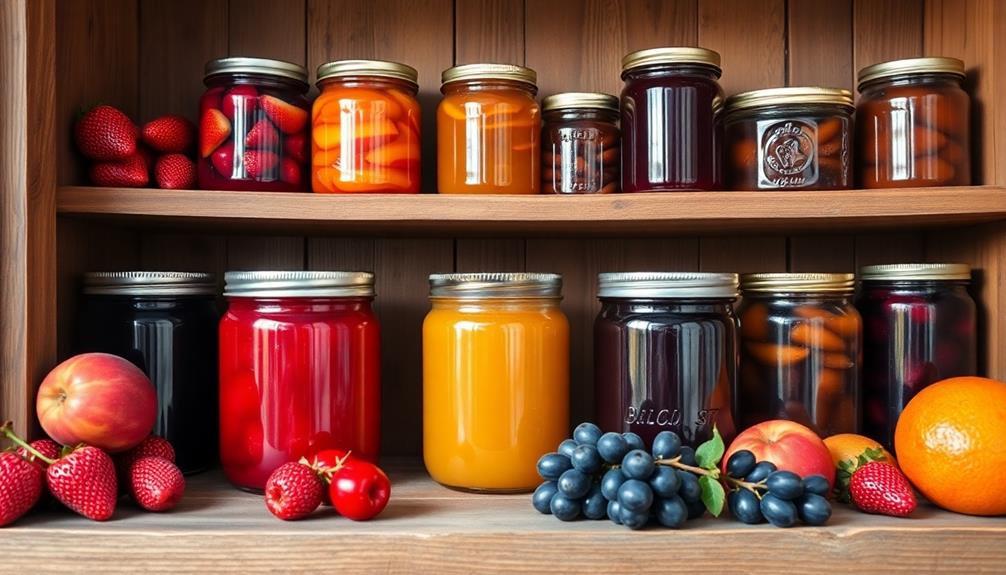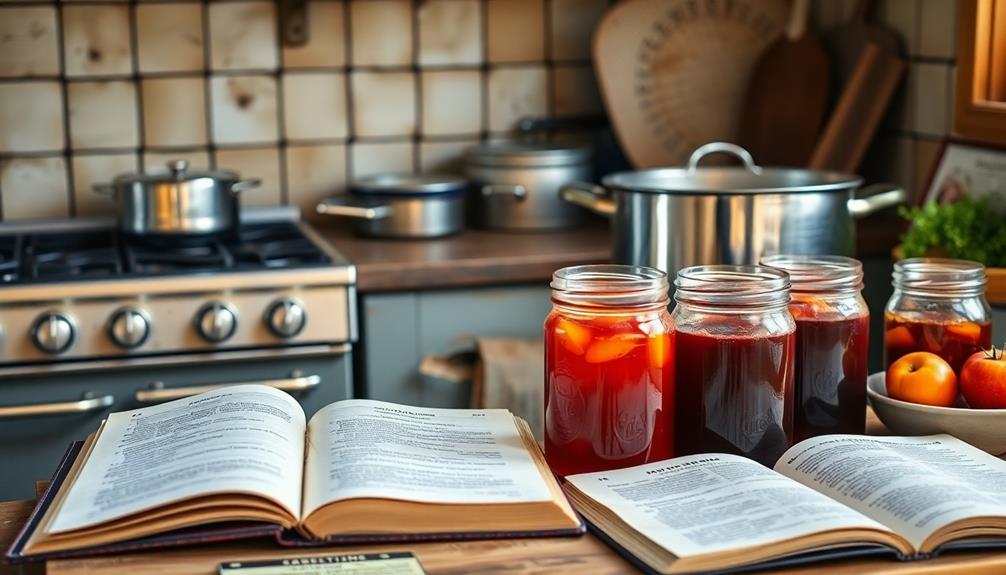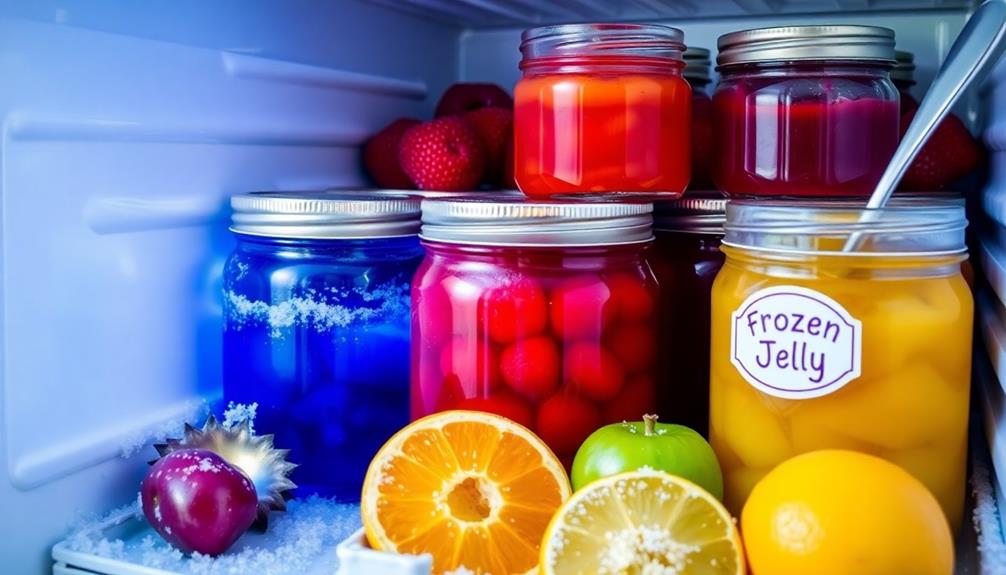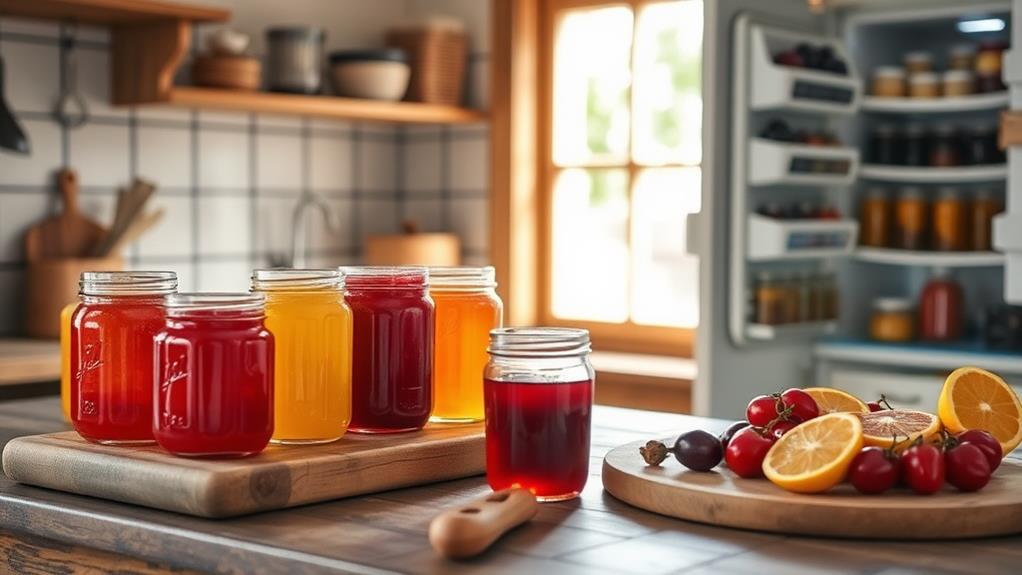Jelly can last quite a while if you store it correctly. Unopened jars can stay good for up to 12 months in a cool, dark pantry. Once opened, keep it in the fridge, where it'll last around six months. Always check for signs of spoilage, like mold or off-odors. Make certain your jars are well-sealed to prevent air exposure. If you're making homemade jelly, sterilize your jars and store sealed ones in a cool, dark place. Freezing is also an option for extended storage. Stick around, and you'll discover even more tips to keep your jelly fresh and tasty!
Best Storage Practices
To keep your jelly fresh and safe to eat, it's crucial to follow the best storage practices. For an unopened jar of jam, you can store it in a cool, dark pantry for up to 12 months without significant quality loss.
If you're dealing with homemade jelly, proper canning techniques can extend its shelf life to about one year, provided the jars stay sealed and are kept in similar conditions. Consider incorporating efficient bill tracking into your routine to manage your food expenses effectively.
Once you've opened a jar, refrigerate it at 40°F or lower to maintain its quality. Opened jelly typically lasts about six months when stored properly. Always be vigilant and check for signs of spoilage before consuming your jelly. Look for mold growth, off-odors, or any unusual changes in color or texture. If any of these signs appear, discard the jelly immediately for food safety.
To maximize freshness, use sterile utensils when scooping jelly from the jar. Non-sterile utensils can introduce harmful microorganisms, compromising the quality and safety of your jelly.
Following these practices will help you enjoy your jelly longer and keep it safe for your family.
Shelf Life of Opened Jelly
Once you open a jar of jelly, it can last about six months in the fridge.
To guarantee your jelly maintains its quality, monitoring and tracking its storage conditions is essential, similar to how one might track savings and investments.
However, you should always keep an eye out for signs of spoilage, like off odors or mold.
Storing it at 40°F or lower is key to maintaining its quality and safety.
Refrigeration Duration
Opened jars of jelly should be refrigerated to maintain their quality, and it's best to consume them within six months. This is essential for ensuring peak quality and minimizing spoilage.
When you open a jar, exposure to air can introduce mold and bacterial spores, which can degrade your jelly over time. To maximize freshness, keep these tips in mind:
- Store at 40°F or lower: Keeping your opened jars in a proper refrigeration setting can help them last about one month after opening.
- Seal tightly: Always close the jar tightly after use to limit air exposure and reduce the risk of mold growth.
- Check regularly: Make it a habit to inspect your jelly for any signs of spoilage, such as off-odors or ingredient separation.
Prompt consumption of opened jelly is advisable. By adhering to these guidelines, you'll enjoy your jelly at its best and avoid any unpleasant surprises.
Signs of Spoilage
How can you tell if your jelly has gone bad? When checking opened jars, look for clear signs of spoilage. The most obvious indicators include the presence of mold, which can appear as fuzzy spots on the surface, and yeast, which may manifest as bubbles or a foamy texture.
If you notice any off-odors—especially a fermented smell—it's a sign that the spoilage process has begun, and you should toss the jelly.
Another red flag is ingredient separation. If you see water pooling on top of your jelly, it's a strong indication that it's degraded and not safe to eat.
Additionally, keep in mind that exposure to air and using non-sterile utensils can introduce harmful microorganisms, speeding up the spoilage process.
For your safety and the best quality, consume opened jelly within six months and regularly inspect it for these signs of spoilage.
If you see any mold, yeast, or experience unpleasant smells, don't hesitate to discard it. Trust your senses; when in doubt, it's better to be safe than sorry!
Shelf Life of Unopened Jelly

When it comes to unopened jelly, ideal pantry conditions can make all the difference in its shelf life.
Always pay attention to the expiration date on the label, as it provides specific guidelines for quality.
Additionally, leveraging timely reminders for upcoming bill payments can help you manage your pantry inventory effectively, guaranteeing you use products before they expire.
With some simple long-term storage tips, you can guarantee your jelly stays fresh and delicious for as long as possible.
Ideal Pantry Conditions
Unopened jelly can thrive in your pantry for up to 12 months if you create the right conditions. The high sugar content in jelly acts as a natural preservative, inhibiting bacteria growth and extending its shelf life.
To guarantee your jelly maintains its quality, follow these ideal conditions:
- Store in a cool, dark place: Place your jelly jars away from heat sources and direct sunlight. Excessive heat can accelerate spoilage and degrade the flavors of your favorite jam.
- Avoid moisture: Keep your storage area dry. Moisture can lead to mold and spoilage, compromising the jelly's integrity.
- Check for temperature stability: Ideally, maintain a consistent temperature. Fluctuations can negatively impact the quality and safety of your jelly.
Expiration Date Importance
Understanding the expiration date on your jelly jar is crucial for guaranteeing its quality and safety. Typically, unopened jelly can last up to 12 months when properly stored in a cool, dark pantry, as per USDA guidelines. The expiration date indicates the manufacturer's guarantee for quality, but it's significant to recognize that unopened jelly may still be safe to eat beyond this date if it's been stored correctly.
The high sugar content in jelly acts as a natural preservative, inhibiting bacterial growth and extending its shelf life. However, be mindful that after the expiration date, you might notice signs of quality degradation, such as color changes or sugar crystallization. These changes don't automatically mean the jelly is unsafe; if there's no spoilage visible, it can still be consumed.
To maintain freshness, verify that your jelly jars are properly sealed and kept away from direct sunlight and heat sources. By paying attention to the expiration date and storing your unopened jelly in the right conditions, you can enjoy its sweet goodness well past the printed date while guaranteeing safety.
Long-Term Storage Tips
To keep your jelly tasting great for an extended period, focus on proper storage techniques. Unopened jelly can last up to 12 months in the pantry, thanks to its high sugar content, which acts as a natural preservative.
However, for peak quality, follow these long-term storage tips:
- Store in a cool, dark place: Keep your jelly away from heat sources and direct sunlight to prevent degradation.
- Check the seal: Verify the jar seal is intact. If it's compromised, the jelly may spoil even if unopened.
- Mind the "use by" date: Always check the date on the label. While unopened jelly can last beyond 12 months, quality may decline due to sugar-resistant yeasts.
Signs of Spoilage
Jelly can spoil in several noticeable ways, and recognizing these signs is key to ensuring your safety. One of the most obvious signs of spoilage is the presence of mold, which can appear as white fuzzy patches on the surface. If you see this, it's a clear indication that harmful microorganisms have developed, so discard the jar immediately.
Additionally, it's important to store your jelly properly to prolong its shelf life; improper storage can lead to quicker spoilage, much like how expense management apps help streamline financial organization.
You should also be wary of off-odors; if your jelly smells yeasty or has a fermented scent, it's best not to consume it. Another visual indicator is ingredient separation, where you notice water and sugar breaking down. This shows the jelly's quality is deteriorating, making it potentially unsafe.
Additionally, if your jelly has an unusual texture or exhibits changes in color, like darkening, these can signal spoilage. Always trust your instincts—if something seems off, it's better to be safe than sorry.
Proper Canning Techniques

Recognizing the signs of spoilage is fundamental for enjoying your jelly safely, but proper canning techniques can help prevent these issues from arising in the first place. To guarantee your jelly remains safe and delicious, follow these essential steps:
1. Sterilizing Jars: Before you begin the canning process, sterilize your jars and lids by boiling them or running them through a dishwasher. This step eliminates any harmful bacteria that could spoil your jelly.
Additionally, using proper budgeting tools can free up funds for high-quality ingredients, enhancing your jelly-making experience with premium flavors. Consider budget management tools to maximize your resources.
2. Water Bath Canning: Use the water bath method for high-acid foods like jelly. This technique effectively kills bacteria and seals the jars, guaranteeing their shelf stability for long-term storage.
3. Follow Recipe Instructions: Stick to precise processing times and temperatures when making jelly. Proper headspace is also important; fill your jars correctly to allow for sealing and expansion.
After cooling, check the integrity of the seals. Broken seals can lead to spoilage, so discard any jars that aren't securely sealed.
Storing Homemade Jams
When it comes to storing homemade jams, proper techniques can greatly extend their shelf life and maintain quality. First, confirm your jars are sterilized before filling them with your delicious homemade jam. This step helps prevent contamination and allows your jams to last longer.
Additionally, consider implementing a system for tracking the ingredients used in your jams, as this can aid in budgeting for future batches and enhance your overall streamlined bookkeeping processes.
Store your sealed jars in a cool, dark place with temperatures between 50 and 70°F. If you follow these guidelines, your homemade jams can last up to 12 months.
Once you open a jar, it's essential to refrigerate it immediately. For peak quality, aim to consume your jam within 1-2 months. Remember to regularly check for signs of spoilage, such as mold, off odors, or ingredient separation. If you notice any of these signs, it's best to discard the affected jars to maintain food safety.
Don't forget to label your jars with preparation dates. This simple step helps you monitor freshness and maintain a good rotation system.
Freezing for Extended Storage

Freezing is an effective method for extending the storage life of your jelly while preserving its quality and flavor. When done correctly, you can keep your homemade jelly for up to a year.
To guarantee ideal freezing, follow these tips:
- Use Airtight Containers: Always use airtight containers or freezer-safe jars to prevent freezer burn and maintain flavor. Tools for effective savings goal setting can help you budget for additional ingredients or supplies if needed.
- Leave Headspace: Don't forget to leave some headspace in your containers. Jelly expands as it freezes, and this space will help avoid any messy spills.
- Thaw Gradually: When you're ready to use your frozen jelly, thaw it in the refrigerator overnight. This gradual temperature change helps maintain its texture.
Once thawed, aim to consume your jelly within a few weeks for the best quality.
Remember, you shouldn't refreeze jelly after it's been thawed. If you have quick or freezer jellies that you haven't used within a week of refrigeration, freezing is your best option to keep them fresh.
Conclusion
To summarize, keeping your jelly fresh is easier than pie! Whether you've got homemade delights or store-bought favorites, following the right storage practices can make all the difference. Remember to check for spoilage signs and adhere to proper canning techniques to guarantee your jelly lasts as long as possible. And if you're looking to extend its life even further, freezing works wonders. Enjoy your tasty treats without worry, and savor every last spoonful!



